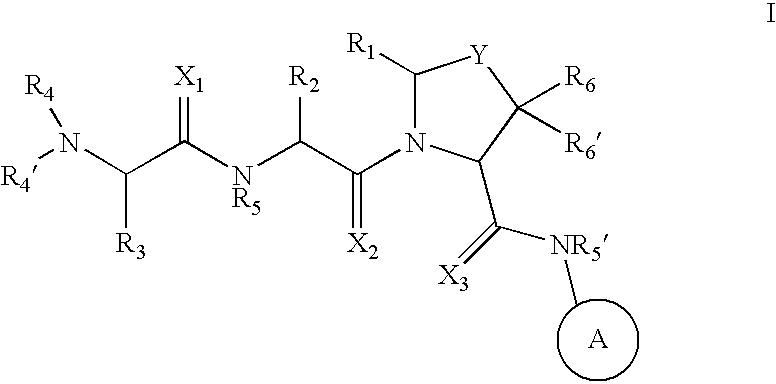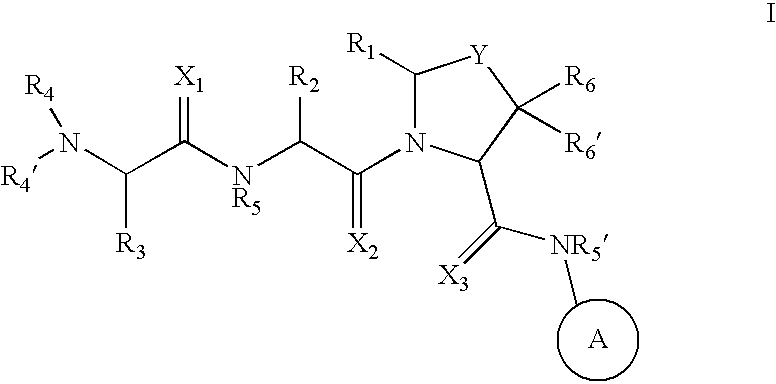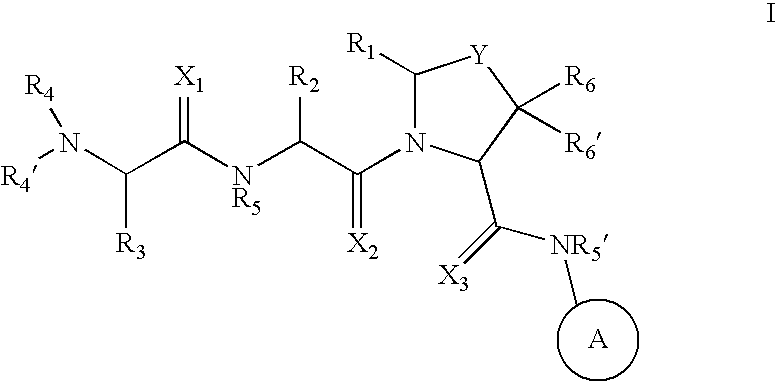Inhibitors of IAP
a technology of iap and inhibitors, which is applied in the field of organic compounds, can solve the problems that chemotherapeutic agents are significantly less effective in killing cells, and achieve the effect of inhibiting binding
- Summary
- Abstract
- Description
- Claims
- Application Information
AI Technical Summary
Benefits of technology
Problems solved by technology
Method used
Image
Examples
example 1
6-(1,3-Dioxo-1,3-dihydro-isoindol-2-yl)-5-oxo-octahydro-thiazolo[3,2-a]azepine-3-carboxylic Acid Ethyl Ester
[0118]
[0119] To a stirred solution of N-(Diphenylmethylene) glycine t-butyl ester 1 (3.0 g, 10.1 mmol) and chiral catalyst O-Allyl-N-(9-anthracenylmethyl)-cinchonidium bromide (613 mg, 1.0 mmol) in dry DCM (30 mL) was added cesium hydroxide (17 g, 101 mmol). The reaction was cooled to −78° C. in a dry ice acetone bath and 4-bromo-1-butene was added dropwise. After addition the reaction was stirred vigorously under N2 at −48° C. for 48 hours. Ethyl ether was added followed by H2O. The organic layer was seperated and washed 2× with H2O, 1× brine, dried with MgSO4 and concentrated. The product was purified by SiO2 chromatography over a gradient of 0-10% EtOAc in Hexanes to give 2 in 65% yield.
[0120] To a stirred solution of 2 (1.52 g, 4.3 mmol) in dry MeOH (50 mL) was added NaOAc (720 mg, 8.6 mmol) and NH2OH.HCl (540 mg, 7.6 mmol). Stirred under N2 at room temperature for 2 ho...
example 2
1-[2-Cyclohexyl-2-(2-methylamino-propionylamino)-acetyl]-pyrrolidine-2-carboxylic Acid (2-phenyl-2H-pyrazol-3-yl)-amide
[0129]
[0130] A solution of Boc-MeAla-Chg-Pro-OH (47.0 mg, 0.107 mmol) and pyridine (26 μl, 0.32 mmol) in anhydrous dichloromethane (300 μl) was cooled to 0° C. and a solution of oxalyl chloride in dichloromethane (54 μl, 2.0 M, 0.11 mmol) was added dropwise over 10 minutes. The mixture was stirred at 0° C. for 15 minutes, then at ambient temperature for 45 minutes, and a solution of 5-amino-1-phenylpyrazole (15.9 mg, 0.100 mmol; TCI America catalog # A0174) and pyridine (15.5 μl, 0.191 mmol) in dichloromethane (0.5 ml) was added. The resulting mixture was stirred at ambient temperature for 16 hours, diluted with dichloromethane to 20 ml, and washed with 0.2 N aqueous sodium hydroxide (20 ml). The organic phase was dried (MgSO4) and concentrated under reduced pressure. The crude product was purified by column chromatography (silica gel, 60% ethyl acetate in hexanes,...
example 3
4-Phenyl-[1,2,3]thiadiazol-5-ylamine
[0131]
[0132] 2-bromoacetophenone was dissolved in DMF (3 vol) and potassium phthalimide (1.1 eq.) was added. The reaction, initially mildly exothermic, was stirred overnight at room temperature. The DMF was removed in vacuo and the reaction was diluted with DCM (˜3 vol) followed by 0.1N NaOH (˜3 vol; 1:1 aq / org) and stirred vigorously then extracted. The organic layer, containing some solid material, was concentrated in vacuo and the resulting solid was slurried in diethyl ether and collected by suction filtration to give (a) as a white crystalline solid in −95% yield.
[0133] Compound (a), ethyl carbazate (1.5 eq) and TsOH—H,O (0.1 eq) were combined in toluene (5 vol) and heated to reflux using a Dean-Stark trap to remove water. The solution turned a dark red color and was complete by TLC in −2 hrs. Approximately half of the toluene was removed by distillation, the solution was cooled to r.t. and concentrated in vacuo. The resulting solid was sl...
PUM
 Login to View More
Login to View More Abstract
Description
Claims
Application Information
 Login to View More
Login to View More - R&D
- Intellectual Property
- Life Sciences
- Materials
- Tech Scout
- Unparalleled Data Quality
- Higher Quality Content
- 60% Fewer Hallucinations
Browse by: Latest US Patents, China's latest patents, Technical Efficacy Thesaurus, Application Domain, Technology Topic, Popular Technical Reports.
© 2025 PatSnap. All rights reserved.Legal|Privacy policy|Modern Slavery Act Transparency Statement|Sitemap|About US| Contact US: help@patsnap.com



